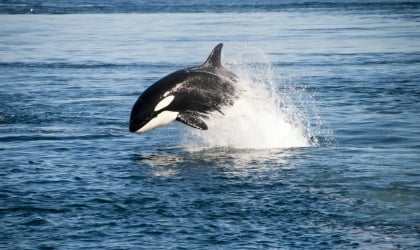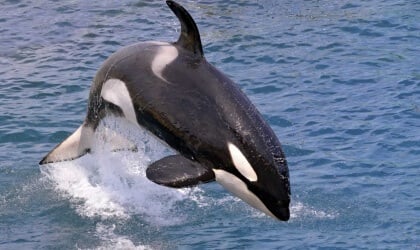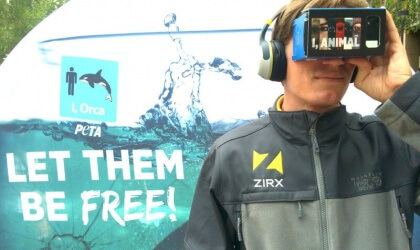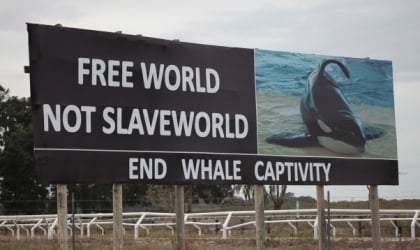Kshamenk, an orca who was abducted from his family in their ocean home, is being held in a cramped tank at Mundo Marino, a marine park in Argentina.

He is thought to have been around 4 years old when he was captured in 1992, and he has been without the company of another orca since 2000, when Belén—the female orca he was held with—died. He has now spent 30 years confined to a small tank.
Many speculate that boats were used to strand Kshamenk and other members of his pod in order to take them captive under the guise of rehabilitation. Unsurprisingly, they were never released back into the sea but were kept as living toys instead.
Mundo Marino continues to profit from Kshamenk’s misery.
A Look Inside Mundo Marino
Although Argentina’s Mundo Marino is unknown to most Americans, there’s one U.S. company that’s intimately familiar with the South American marine abusement park: SeaWorld.
According to former orca trainer turned author John Hargrove, before SeaWorld ended its sordid orca-breeding program, the company sent staff to Argentina to train Mundo Marino’s lone orca to allow humans to collect his semen. SeaWorld then reportedly used that semen to inseminate at least two of the female orcas held captive at its parks in the U.S., and one of these cases has been described by Hargrove: It’s Kshamenk’s semen that I used on Takara in July 2011 to get her pregnant. She lost that calf in March (2012), and all they did was wait for three months and then they re-artificially inseminated her again.”
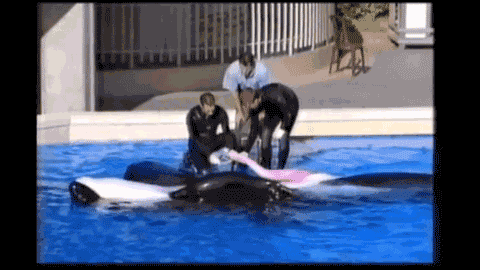
Kshamenk’s semen was shipped to the U.S. in order to fuel SeaWorld’s now-defunct orca-breeding program. To produce as many animals as quickly as it could, SeaWorld impregnated some of its female orcas before they had reached full sexual maturity. This meant that many of the young mothers—deprived of the rich family structure of a wild pod—never learned to care properly for their own babies, creating a cycle of misery. The extent of the problems with SeaWorld’s breeding program is shocking. Among many other issues, stillbirths were common, and females who had recently given birth were impregnated again before their bodies had recovered.
Kshamenk Suffers at Mundo Marino
Kshamenk—like all captive adult male orcas—has a collapsed dorsal fin, a condition that’s extremely rare in nature and indicative of stress, injury, or ill health. Being confined to a woefully small tank has taken a massive toll on him. Video footage recorded at Mundo Marino shows him exhibiting a troubling behavior known as “logging”:
Deprived of mental stimulation, Kshamenk can often be seen floating listlessly for minutes at a time on the surface of the water—as if he has given up all hope. And why wouldn’t he have?
In the following video, you’ll see Hargrove highlight just some of the unethical practices that went on behind the scenes at SeaWorld parks:
Kshamenk’s Story Isn’t the Only Tragedy to Come Out of Mundo Marino
Visitors to Mundo Marino sent PETA video footage showing sea lions who were languishing in distressing conditions at the horrendous operation.

The sea lions’ enclosure offered no reliable shade in which they could escape the sun. Their cloudy eyes bore the blue tint of cataracts, and in order to beg for food, they were obliged to look up—directly into the blinding sunlight. Captive pinnipeds (seals, sea lions, and walruses) like these often suffer from poor eye health at marine parks, and evidence of this abounds at Mundo Marino.

PETA Foundation Senior Veterinarian Heather Rally reviewed images of the sea lions and noticed that several had visible areas of alopecia areata (fur loss), which she believes is likely the result of repetitively rubbing their skin against hard surfaces. These hairless patches suggest that the animals may be engaging in stereotypic (i.e., abnormal and repetitive) behavior, which indicates that they’re stressed. Animals forced to live in extreme captivity can become so frustrated that they begin to perform the same motions over and over again, not even pausing once they’ve begun to harm themselves.

In addition, Dr. Rally says that the park visitors were allowed to get so close to the sea lions that both the animals and the humans were at risk of serious injury.
A tiny tank will never be a sufficient substitute for the open ocean. Deprived of the rich social lives they’d have in nature, captive marine animals endure physical and mental suffering, which is evident at places like Mundo Marino and SeaWorld’s facilities in the U.S.
Want to Help Captive Marine Animals?
Never support companies that profit from the confinement of cetaceans, pinnipeds, or any other animals. Tell everyone you know not go to marine parks. Urge SeaWorld to retire the animals currently held in its tanks to coastal sea sanctuaries, and share this post on Facebook and Twitter.

